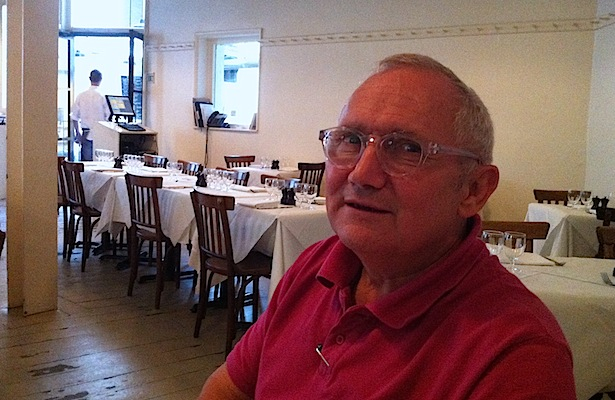“A good restaurant is an old friend,” says Trevor Gulliver.
A good restaurant is St. John, on St. John Road just up from the Smithfield meat market on the edge of the City of London. It’s mostly known by its chef, Fergus Henderson, and its British sourced menu which is centred on the philosophy of nose to tail eating. But St. John is more than the food it serves, as delicious and sought after as it is. For instance, there’s the specially chosen white plates themselves, and the democratically solid stemware that accommodates any and all of the carefully chosen and made wines on their list. There is also the dining room and bar, and the staff who serve in a friendly and competent way. There is all that and more, and the devil in the details of each is St. John’s other founding partner and CEO, Trevor Gulliver.
My wife, Apple, and I were lucky enough this August to catch Trevor in London, as he was en route between the St. John winery in the Southwest of France and Oxfordshire where he, Fergus and other St. John crew were helping to cater a music festival. I had met and got to know Trevor twice before: first when he accompanied Fergus to the fifth Terroir Symposium in March 2011 in Toronto and Jamie Drummond and I spent a day eating our way around the city with them, and second when he returned to Canada last spring for the seventh Terroir, where he presented on the topic of ‘gastronomy’ (no such thing, he suggested). That time, I saw him in Toronto and again in Montreal for more eating, sportsman’s store shopping and some time spent at the bar at L’Expresse, which very nearly caused me to miss my train home. By a coincidental parallel, I had dined at St. John twice before. Once for lunch with my wife nearly a decade ago, and again at Thanksgiving in 2009, when I was in London for a wine conference and managed to collect three other Canadians for a celebratory dinner. (Chitterlings with dandelion salad turns out to be a remarkably good stand in for turkey, by the way.) So, this lunch was the third meeting of both for me, and promised to be good fun as I would observe Trevor in his natural habitat. It was a social occasion, not a working one, so I took no notes and just the quick souvenir picture above*. Still, I took away more from the experience than a lovely long lunch with beautifully cooked food, lovingly made wines and good company. Trevor gave me a few ideas. And as Apple and I walked off the last digestif in the early London evening, I madly typed a few quotes of Trevor’s into my phone to share below.
Trevor’s Twitter handle is @Mrs_St_John, which is speaks to his sense of humour but also his theory of hospitality. I have, in my small way, contributed to the current culture of the celebrity chef. Chefs have become the natural focus of the media that cover food culture in the Western world, since they mirror most closely the auteur, or artist, model of creative production. The product is an assemblage of protein, starch and vegetable fiber that can be attributed to the woman or man who runs the kitchen in which it is made. It’s a useful way to explain the success of a restaurant. Furthermore, the chef’s work can be translated into other media, like cookbooks or television shows, again in a way that makes for good story telling that is easily digested, if you’ll forgive the metaphor, by the public at large. But how do you do that with the design of a room? Or a standard of service that’s disciplined and professional while being open and welcoming? Or the subtleties of a wine program? That’s harder, so it doesn’t get tried very often. The irony, which “Mrs. St. John” understands, is that the man responsible for the front of the house, is obscured in our culture by the man at the back.
“You have to like food to come here,” says Trevor as the first dishes arrive (brown crab on toast, mussels, sardines). The kitchen at St. John is tiny, and can’t take up more more than 10% of the main building area of the restaurant that includes the dining room. It’s a sort of galley, with an adjoining closet of a prep space that is mostly in plain view. “Everyone in that kitchen cooks,” he adds later, explaining that employment at St. John is prized not just because of its status a one of the world’s great and recognized restaurants, but also (and it is implied more importantly) because time in its kitchen will be filled with lessons on how to do just about everything and anything that happens there. So, of course, this is a place about food. Its most famous dish arrives after the seafood: roast marrow bones with parsley salad. This dish has spread around the Anglosphere, but in my experience not always successfully. At St. John they are veal bones, which are considerably smaller than the Flintstones ones that seem to be routinely served on this side of the Atlantic. And the salad, with capers and vinegar (or is it lemon?) to cut and balance the fat, is a key and fully integrated part of the show, not some afterthought or garnish. It’s a wonderful dish, and should rightly be on anyone’s must eat before I die list. But would it taste as good if it were slammed on the table with a grunt, served in a Styrofoam clam shell, on a plastic table with metallic swivel chairs? No, I don’t think it would. The following may be an unanswerable riddle, but it serves the purpose of illustrating why gastronomy is impossible without hospitality. Would you rather have a delicious dish served in an unwelcoming and rudely staffed restaurant, or a crappy meal served in a welcoming atmosphere by kind and generous people?
“We have regular customers who only come here once a year,” says Trevor. I know what he means. I have been only thrice in 10 years, but I feel like St. John is my restaurant. This is not an accident, its by Trevor’s design. He points up about midway up the walls, which support the dining room’s very high ceiling. There is a row of coat hooks that encircles the polygonic room. Trevor explains they were installed at opening with the view that they wanted their customers to feel relaxed as soon as they entered. Before he formed his partnership with Fergus, and found the disused smokehouse that became this, their first, restaurant, Trevor was a partner in The Fire Station, on the south bank of the Thames, near Waterloo train station. It was very much on the cutting edge of the gastropub movement, championing British foods before it became de rigueur. But it was also, Trevor explained, the first public building in Britain to be converted into a restaurant. While profiles of Fergus will always mention that he trained as an architect, it was Trevor who saw the potential of the St John Road venue and who created the fantastic experience of coming through the long passageway from the street into the naturally lit open space of the bar, and up the stairs to the enclosed dining room, where pegs signal you that you have arrived, you may relax and let’s consider something to drink to get things going.
One thing about Trevor, which is apparent immediately to anyone who spends more than a minute in his company, is that he does not suffer fools. Another thing is that his standards are high. At the bar Toronto’s Soho House, I sat with Trevor while he sent back two versions of a Negroni until the very young bartender got the mix right. To the bartender’s credit, he remixed the drinks cheerfully and thanked Trevor for the lesson. I think he’d do well at St. John. The danger with exacting standards of restaurant service is it can quickly turn into formality or (maybe worse) fussiness. A good restaurant that is an old friend can neither be formal or fussy. The service at St. John (which I have experienced twice before without the benefit of sitting at one of the owner’s table) is deft: they’re there at the right time, like when a glass needs to be refreshed, and pace the meal well. It’s also casual and familiar in so far as it may turn conversational, but it doesn’t exude the fake and forced intimacy that can be more than a bit too much. The service at St. John is also, I have noted, delivered in a full array of accents from the English speaking world (and possibly beyond). It’s not just the kitchen where young restaurant workers come to learn.
So, here’s to Trevor who, with Fergus, created my old friend, which I regularly visit every few years.
* I did take that day’s menu, which Trevor signed. Or, I thought I did. Back in Toronto, when I took it out of my bag and unfolded it, I realized I had actually taken the drinks menu. Oh well.
 Malcolm Jolley is a founding editor of Good Food Revolution and Executive Director of Good Food Media, the company that publishes it. Follow him at twitter.com/malcolmjolley
Malcolm Jolley is a founding editor of Good Food Revolution and Executive Director of Good Food Media, the company that publishes it. Follow him at twitter.com/malcolmjolley







